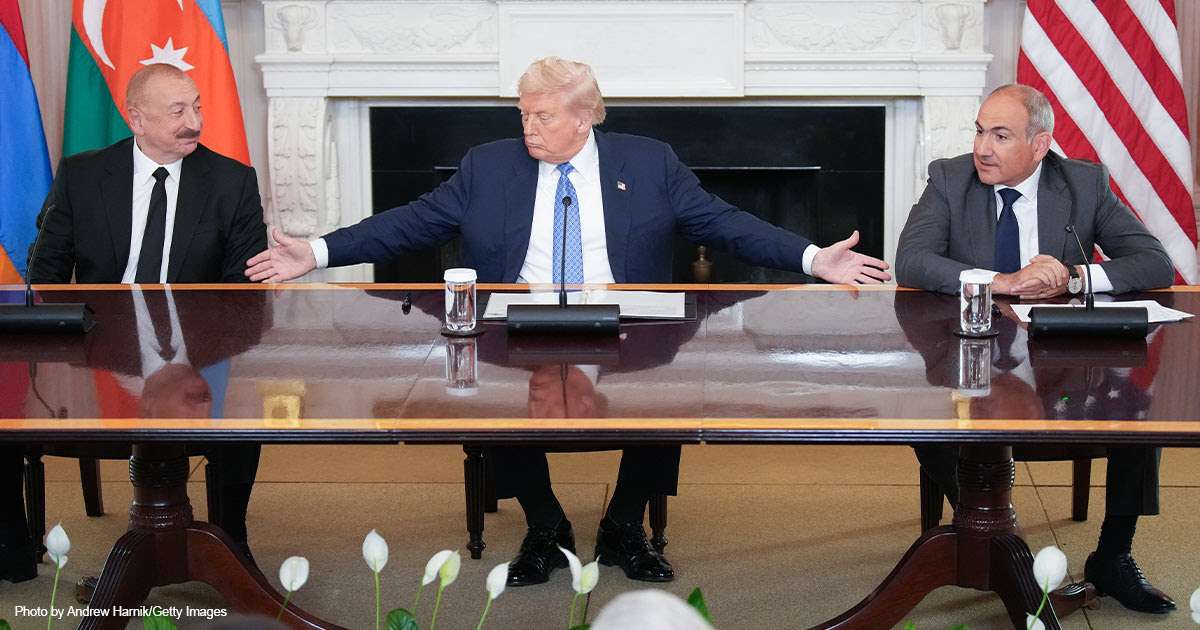Trump Orchestrates Armenia-Azerbaijan Peace Deal, U.S. Involvement in the Caucasus Mountains

Washingtonstand.com
President Donald Trump orchestrated yet another peace deal on Friday, coaxing Armenia and Azerbaijan to settle decades of differences with the prospect of an economic windfall — of which America would take its own slice. This strategic settlement also siphons support away from America’s adversaries out of their own backyard, prying the Caucasus states away from the influence of Russia and Iran.
On Friday, Trump sat between Azerbaijani President Ilham Aliyev and Armenian Prime Minister Nikol Pashinyan, as they signed the historic peace deal at the White House. “For more than 35 years, Armenia and Azerbaijan have fought a bitter conflict that resulted in tremendous suffering for both nations. … Many tried to find a resolution … and they were unsuccessful. With this Accord, we’ve finally succeeded in making peace,” he announced.
According to the text of the agreement released Monday, both nations pledge to respect the other’s territorial integrity, relinquish all claims to the other’s territory, and respect international law.
In separate agreements, the two nations also gave the U.S. exclusive rights to develop a strategic corridor across both nations that would include rail lines, oil and gas pipelines, and telecommunication lines. The Zangezur Corridor, rebranded as the Trump Route For International Peace and Prosperity (TRIPP), would run across southern Armenia near the Iranian border, connecting Azerbaijan with the Nakhchivan Autonomous Republic, an Azerbaijani exclave lying west of Armenia that shares a land border with Turkey.
This corridor attempts to address the complex, mixed-up geography of the mountainous Caucasus region, which contributes to the tensions between Armenia and Azerbaijan. In 1919-20, Azerbaijanis in Nakhchivan revolted from the Armenian government and have remained a distinct political entity ever since. In the late 1980s, the majority-Armenian region of Nagorno-Karabakh revolted from Azerbaijan, which entirely surrounds it. It remained autonomous with Armenian assistance until Azerbaijan recaptured the territory and finally suppressed the uprising in 2023, which caused approximately 100,000 Armenians to flee the territory.
In 2002, the two nations discussed a land swap, in which Armenia would gain access to Nagorno-Karabakh, and Azerbaijan would gain access to Nakhchivan through a southern corridor (then called the “Meghri corridor”).
Now that Nagorno-Karabakh has been recaptured by Azerbaijan, it’s unclear what Armenia will gain in return for giving Azerbaijan access to this southern corridor. This might hinder the deal’s implementation, since Azerbaijan wants Armenia to amend its constitution to “eliminate territorial claims against Azerbaijan.” If Armenians don’t see any upside, the referendum to amend the constitution may fail.
Perhaps the upside for Armenia comes in the form of investment by American companies, who will enjoy exclusive development rights in the corridor on a 99-year lease. At the very least, this fact shows an American interest in preserving peace in the Caucasus.
From America’s perspective, a trade route through Azerbaijan and Armenia not only unlocks the Caucasus states, it also serves as a strategic bypass to central Asia around our geopolitical adversaries. For the five former Soviet states in central Asia (the “-stans”), commercial intercourse with Western nations has only ever been a distant possibility because they are landlocked and ringed by Western adversaries — Russia, China, Afghanistan, and Iran. A trade route across the Caspian Sea, through Azerbaijan and Armenia, would effectively open to these nations a new Silk Road.
(The trade corridor would also benefit Turkey, which would control its western terminus.)
Conversely, the nations hurt by Trump’s Caucasus peace deal are America’s other geopolitical adversaries. The U.S.-managed corridor evades the cartel-like collusion between Russia and Iran and disrupts China’s Belt-and-Road initiative. It also bypasses Georgia, which was invaded by Moscow in 2008 but is now run by a pro-Russia regime. It is noteworthy that Trump achieved a peace deal where neither Russia nor Iran had succeeded in more than three decades — thus eclipsing the influence of both authoritarian regimes in the narrow mountain range that divides them.
The most vehement opposition of the American-run corridor has come from Iran. Ali Akbar Velayati, a senior advisor to Iran’s supreme leader, declared publicly on Saturday that Tehran would disrupt America’s effort “with or without Russia.” Lest anyone should misinterpret his meaning, he added a clear threat of violent terrorism, “This passage will not become a gateway for Trump’s mercenaries — it will become their graveyard.”
The Armenia-Azerbaijan peace deal suggests that longstanding alliances in the region may be changing rapidly — or perhaps that regional dynamics have already shifted, with more changes to follow. The fall of Assad’s regime in Syria, followed by Iran’s total defeat in its war against Israel, showed that Russia is no longer able to defend its interests in the Middle East, hampered as it is by Putin’s windmill-tilting in Ukraine.
Columnist Melik Kaylan suggested that Russia’s evident weakness has forced Armenia to rethink its strategic alliance and find a new great power to protect them from their Turkic adversaries (including both Azerbaijan and Turkey). This has bolstered the case of Armenia’s pro-Western leader, who is desperate to find another powerful backer after losing the war for Nagorno-Karabakh.
There is a religious aspect to the conflict as well. Armenians have identified as Christian for 1,700 years, perhaps longer than any other people group. Their Turkic adversaries are Muslim, especially Turkey’s Islamist leader Recep Tayyip Erdogan. Turkey’s hatred of Armenia runs deep, even leading it once to commit genocide against Armenians living within its borders. Trapped between an estranged Russia and hostile Muslim neighbors, little landlocked Armenia has no good options — except for the world’s foremost bastion of freedom, the grand old U.S. of A.
Recently, Azerbaijan has also fallen out with Russia. Six weeks ago, two Azeri men died in Russian police custody after being arrested in an organized crime operation. Azerbaijan accused Russia of torturing them to death.
The iron was hot, and President Trump struck. With both Armenia and Azerbaijan angry with Russia, both were willing to listen to an American offer, and the deal was signed.
If the peace deal sticks the landing, this will be at least the fourth global firefight that Trump has smothered in the opening months of his second term. This include India and Pakistan, Rwanda and Congo, Thailand and Cambodia, and now Armenia and Azerbaijan. These deals were not necessarily waiting for Trump’s signature; as recently as May, the International Crisis Group expressed doubt that an Armenia-Azerbaijan peace agreement was possible as tensions mounted.
The Armenia-Azerbaijan peace deal suggests that Middle Eastern geopolitics remain malleable, especially with wars ongoing in Gaza and Ukraine. There remains a possibility for further realignment, perhaps with tectonic implications for Israel and Iran.
“As regional dynamics shift regarding Iran (and Azerbaijan), it could open the way for Armenia and Israel to grow toward a better relationship,” suggested Travis Weber, FRC vice president for Policy and Government Affairs. Israel has historically sold weapons to Azerbaijan as a counterweight to Iran, but that has soured Israel’s relationship with Azerbaijan’s adversary, Armenia; for its part, Armenia maintains a close relationship with Iran, one of its four neighbors.
But Weber suggests that this alignment is not natural. Armenia and Israel “are the only non-Muslim countries in the region — one of the world’s oldest Christian countries and the other the world’s only Jewish country,” he argued. “This positions them to align quite naturally around shared foundational values like freedom — values that are also foundational to Western civilization.”
“Armenia and Israel could form an ‘arc of freedom’ (from Israel, to Kurdish areas, to Armenia — with which it could ‘band’ together) in a region where it is increasingly in short supply,” Weber hoped, “offering help, hope, refuge, and protection to all who need it — whether Druze, Christians, Alawites, and other religious and ethnic minorities in the region.”





